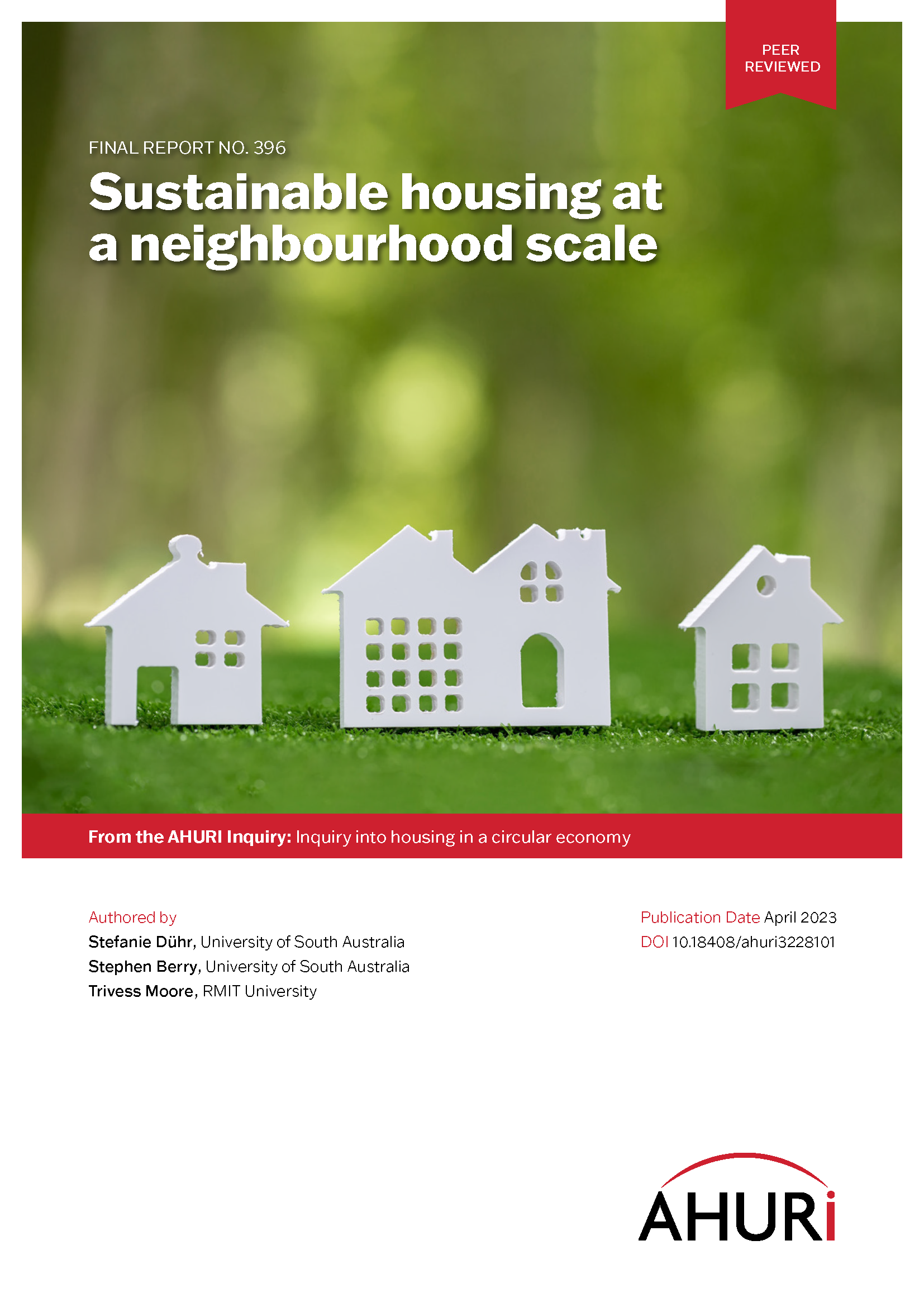
Research reveals missed opportunities to create sustainable homes and neighbourhoods
13 Apr 2023
The lack of planning instruments focussed at the neighbourhood scale in Australian cities means missed opportunities to improve local communities, environments and energy systems, new AHURI research reveals.
The research, ‘Sustainable housing at a neighbourhood scale’, undertaken for AHURI by researchers from University of South Australia and RMIT University, examines the problems policy makers, planners and property developers experience when planning and building sustainable housing developments at the neighbourhood scale. Neighbourhoods can vary in size, but they are clusters of buildings with shared infrastructure and, in scale, fit between individual buildings and the wider urban environment.
Many of the planning and development professionals surveyed for the research expressed disappointment at the low regulatory standards for building performance in Australia. The current requirements are seen to prevent industry innovation and as presenting considerable challenges for local governments trying to negotiate higher standards in planning and development processes.
‘The survey respondents told us it is really difficult to achieve integrated sustainability, transport and land use planning at the neighbourhood scale, because the dominant focus in housing developments in Australia is at the level of individual buildings. We also found that a coordinated approach to ‘green’ natural and open spaces and ‘blue’ water infrastructures at a neighbourhood scale can maximise social benefits for residents. However, because the focus is at the individual building level, those ‘in-between’ public spaces between housing lots are not being given sufficient attention in planning and development processes,’ says lead author of the research, Professor Stefanie Dühr of the University of South Australia. ‘The respondents highlighted similar challenges around supporting local electricity production, such as through neighbourhood battery schemes. Generally, we found weak policies and regulations for helping neighbourhood-scale developments be more efficient in their water and energy use or to more fully integrate transport and land use planning.’
Many of those surveyed said that they do not assess environmental performance at the neighbourhood scale using a rating system. Such responses suggest that unless neighbourhood-scale rating tools are explicitly required by government agencies or clients they will only have limited use in improving urban planning and development processes.
Key barriers to address
While organisations are aware that planning at the neighbourhood scale will also deliver better outcomes for individual dwellings, the research highlighted several barriers, including:
- policy frameworks that perpetuate low standards and prevent both a more integrated perspective of sustainability and the opportunities afforded by planning at the neighbourhood scale
- land ownership structures, especially in greyfield locations (i.e. urban infill sites) where lot consolidation processes were seen as lengthy and costly
- costs/economics of achieving higher standards
- a lack of sufficient technical expertise among key personnel as well as limited opportunities for professionals to combine their expertise in shaping development outcomes.
Key learnings from good practice developments
The research also analysed ten case studies of eco-neighbourhoods from Australia and five from Europe to better understand strategies and policy levers. The case studies highlighted that realising such projects are time-consuming and require strong leadership and dedication to overcoming challenges. The case studies also showed that success requires significant cross-sector cooperation and that policy frameworks play an important role.
Recommended actions to enable sustainability opportunities to be captured in Australia
The researchers proposed a number of ways sustainability opportunities could be better harnessed in Australia, including the introduction of mandatory targets and neighbourhood-scale sustainability rating tools, a review of masterplanning and subdivision processes to strengthen sustainable development goals at building and neighbourhood scale, and the use of binding design guidelines with measurable sustainable objectives. They argue that the neighbourhood scale is overlooked in current planning and development processes, yet is important to achieve more sustainable housing outcomes.
‘Our research emphasises that planning, designing and implementing sustainable housing at a neighbourhood scale will only become more mainstream if the demands are included in planning and building regulations,’ says Professor Dühr. ‘Mandatory targets and binding policies and regulation need to be incorporated across different levels of government and also coordinated between jurisdictions.’
The research also proposes a review of sustainability rating tools currently in use, a review of masterplanning approaches to support neighbourhood-scale residential and mixed-use development, and the creation of design guidelines to ensure that sustainability becomes a binding requirement of large-scale developments. Such strategic master planning documents can provide a decision framework during the years of implementing large-scale development projects.
‘Ultimately, although neighbourhoods are much more complex to plan and implement than individual buildings, they are small enough to innovate in public policy, governance and sustainable urban design strategies, while being large enough to deliver important social and ecological benefits for everyone across the city,’ says Professor Dühr.

